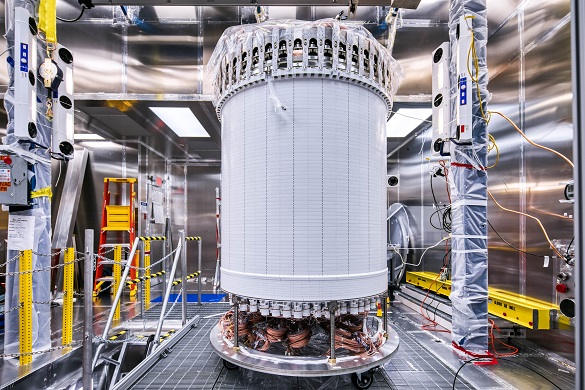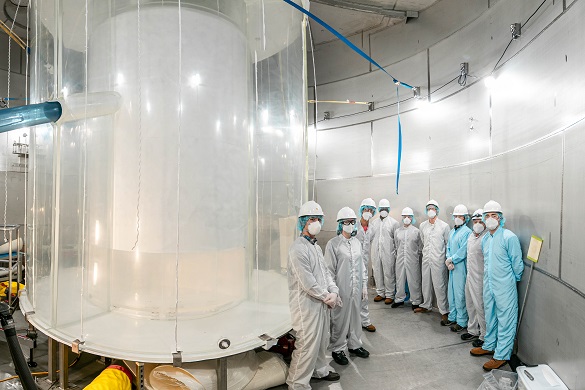Sensitive dark matter detector comes to life
Published on

The world’s largest and most sensitive dark matter experiment, which involves University of Liverpool researchers, has gathered its first result – showing the experiment is successfully operating as designed and offering an insight into the dark matter in the Universe.
The LUX-ZEPLIN Dark Matter Experiment (LZ) is based at the Sanford Underground Research Facility in South Dakota in the US, and involves an international team of scientists and engineers from the US, UK, Portugal, and South Korea.
The experiment now needs to run for up to 1,000 days to realise its full sensitivity. This initial result is just a fraction of that exposure, which validates the decade-long design and construction effort.
What is LUX-ZEPLIN?
LZ is intricately and innovatively designed to find direct evidence of dark matter – a mysterious invisible substance thought to make up most of the mass of the Universe.
Dark matter is particularly challenging to detect, as it does not emit or absorb light or any other form of radiation.
The LZ detector will try to capture the very rare and very faint interactions between dark matter and its 7-tonne liquid xenon target. To do this, LZ must be carefully and delicately calibrated and any background noise removed so the experiment can be perfectly tuned to observe these interactions.
Today, the international project led by the Department of Energy’s (DOE) Lawrence Berkeley National Laboratory (Berkeley Lab) has announced the detector is running as hoped after years of careful set-up.
Professor Henrique Araújo, from Imperial College London, is the UK lead and co-lead for the development of the LZ Xenon Detector. He said: “An experiment of the scale and sensitivity of LZ can be unforgiving: the smallest design flaw may compromise the whole enterprise. And since the LZ cryostat cannot be opened underground, we needed to make sure we got it right the first time, much like if we were to launch LZ into space… Well, it looks like we did get it right.”
The tests show that LZ already is the world’s most sensitive dark matter detector, with plans to collect about 20 times more data in the coming years.
After the successful start, full-scale observations can begin with the hope of finding the first direct evidence of dark matter.
Professor Araújo added: “It’s been a privilege to work in such a fantastic project, full of talented and fun people. The pioneering ZEPLIN programme lives on as the ‘Z’ in ‘LZ’ – but we needed a much larger international team to achieve something on this scale.”
Liverpool’s role
LZ involves 250 scientists and engineers from 35 institutions from the US, UK, Portugal and South Korea.
The Liverpool group, led by Dr Sergey Burdin from the Particle Physics Group in the Department of Physics. joined the LZ project in 2014.
The group successfully delivered Optical Calibration System for LZ Outer Detector, participated in installation of the LZ detector at SURF, developed data analysis and data quality monitoring frameworks, software for outer detector calibration and visualisation, and studied gamma and neutron background originated in the cavern.
Dr Burdin said: “A realisation that we don’t understand 95% of our Universe is fascinating. Vast masses of something unknown and invisible are flying in the space and through us undetected. I could not miss this opportunity to try to “touch” this invisible dark matter so I joined the LZ collaboration to further explore this dark matter world and understand its nature.
“The Liverpool group brought significant technical, hardware and software expertise from its experience in collider and neutrino physics to the dark matter search experiments, with support from our Detector Development Manufacturing Facility.
“Building the LZ detector was challenging especially during the COVID time, and it is great to see that the experiment achieved the best sensitivity to dark matter particles so soon after start of its operation. It will continue improving its sensitivity by collecting more data over the next several years and Liverpool physicists will continue making important contributions to its operation and physics programme."
The UK team, funded by the Science and Technology Facilities Council (STFC), also includes research groups from the universities of Bristol, Edinburgh, Imperial, Oxford, Royal Holloway, Sheffield and UCL and STFC’s Rutherford Appleton Laboratory.
[caption id="attachment_107057" align="alignnone" width="585"] Members of the LZ team in the LZ water tank after the outer detector installation. (credit:Matthew Kapust, Sanford Underground Research Facility.)[/caption]
Members of the LZ team in the LZ water tank after the outer detector installation. (credit:Matthew Kapust, Sanford Underground Research Facility.)[/caption]
Hunting the dark matter
LZ is the largest and most sensitive experiment searching for dark matter particles, in particular Weakly Interacting Massive Particles (WIMPs).
These theorised elementary particles interact with gravity – which is how we know about the existence of dark matter in the first place – and possibly through a new weak interaction too.
This means WIMPs are expected to collide with ordinary matter – albeit very rarely and very faintly. This is why very quiet and very sensitive particle detectors are needed for WIMP detection.
How does it work?
At the centre of the experiment is a large liquid xenon particle detector maintained at -100oC, surrounded by photo-sensors. If a WIMP interacts with a xenon atom, and produces even a tiny amount of light, the sensors will capture it.
But in order to see these rare interactions, the team had to carefully remove all natural background radiation from the detector materials first.
But this is not enough – which is why LZ is operating around a mile underground. This shields it from cosmic rays, which bombard experiments at the surface of the earth. The detector and its cryostat sit inside a huge water tank to protect the experiment from particles and radiation coming from the laboratory walls.
Finally, the team made sure that the liquid xenon itself is as pure as possible by carefully removing a key contaminant through a complex years-long process.
Many complex systems had to come together for LZ to work, and this first results shows they are performing in harmony seamlessly.
STFC’s Dark Matter Group Leader Pawel Majewski said: “It is gratifying to see the LZ experiment delivering its first scientific results.
“For the Rutherford Appleton Laboratory, one of the LZ founding members, it has been a privilege to be part of this wonderful endeavour bringing together scientists and engineers from all over the world.
“We look forward to seeing more exciting results with an anticipation of a significant discovery awaiting us in the years to come.”
[caption id="attachment_107056" align="alignnone" width="585"] Looking up into the LZ Outer Detector, used to veto radioactivity that can mimic a dark matter signal. (credit: Matthew Kapust, Sanford Underground Research Facility.)[/caption]
Looking up into the LZ Outer Detector, used to veto radioactivity that can mimic a dark matter signal. (credit: Matthew Kapust, Sanford Underground Research Facility.)[/caption]
More information about the LZ international collaboration
LZ is supported by the U.S. Department of Energy, Office of Science, Office of High Energy Physics and the National Energy Research Scientific Computing Center, a DOE Office of Science user facility. LZ is also supported by U.S. National Science Foundation; the Science & Technology Facilities Council of the United Kingdom; the Portuguese Foundation for Science and Technology; the Institute for Basic Science, Korea; and the LZ collaborating institutions. The LZ collaboration acknowledges the assistance of the Sanford Underground Research Facility.